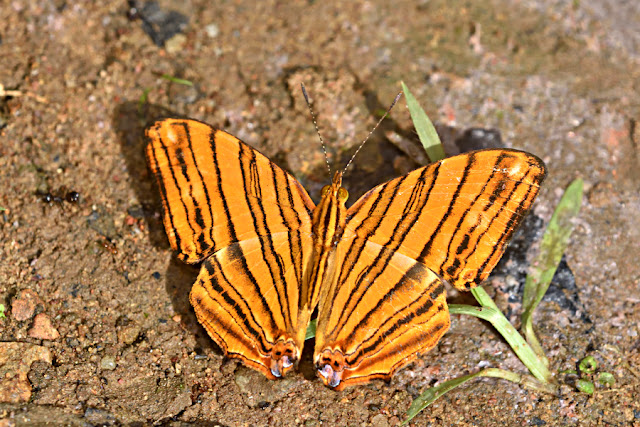Butterflies in the Nymphalidae family have four functional legs only as the first pair of forelegs is reduced, usually covered with dense hairs and useless for walking or perching. There are many subfamilies in this largest and very diverse family of butterflies.
A male Courtesan (Euripus nyctelius nyctelius) was seen puddling on a rocky surface at Doi Suthep on our very first day morning.
With a bit of patience, I managed to get a shot of its upper side wings.
A very skittish Vagrant (Vagrans sinha sinha ) came down to puddle near where our car was parked along a roadside. Vagrant has the habit of flapping its wings constantly even when it is feeding on the something.
After many futile attempts, I managed to get a decent fully open-winged shot.
The Banded Dandy (Laringa horsfieldi glaucescens) was abundant in Chinag Mai and the male is a lot more common.
This species is a lot easier to shoot than the Vagrant. When it found the right spot, it could stay there for a long time.
My first shot of a female at Doi Suthep when she took a short nap at a shady spot.
I was stalking this extremely skittish and alert guy - the Neptis Ankara. It never stayed still on the ground, always scooting off to the canopy level we approached it closer. With a great deal of patience, this is the only 'presentable' shot I could get.
This orange butterfly, the Paral Lascar (Pantoporia paraka paraka ) looks quite similar to the above Sailor but it actually belongs to another genus but in the same subfamily Limenitidinae.There were a few other Sailors at the same location in Doi Suthep. This is the Broad-banded Sailor (Neptis sankara guiltoides) taking a short break on a dry leaf.
I always went for an underside shot if possible.
These black-and-white nymphalids can be very confusing and difficult to identify them. This is the Sullied Brown Sailor (Neptis nata adipala ) found puddling at Chiangdao.
This was my best attempt at shooting its undersides - very challenging as it kept moving and flapping its wings.
It was quite difficult to identify a Neptis in the field with certainty. So I would usually take some shots when opportunities arose. Without much chasing, this guy was shot and it turned out to be a Neptis cartica.
It was more cooperative when I went down on the ground to snap a shot of its undersides.
It looks like a Neptis but it belongs to another genus - the Studdded Sergeant (Athyma asura) - a series of white postdiscal polygonal spots on the upperside of the hind wings make it easier to identify this species.
A perch on a leaf shown by this Lance Sergeant (Athyma pravara indosinica) was my preferred composition for photo-taking.
Lexias pardalis jadeitina was quite common in Doi Suthep. This male was found enjoying the moisture on a rock.
This is another Lexias species - a female L. dirtea toochaii with black antennal tip and subapical white bands on the forewing uppersides.
The Circle (Hestinalis nama nama) which mimics the Parantica sita belongs to the subfamily Apaturinae.
Very skittish and alert fellow, this guy changed its puddling spots very frequently on a late afternoon at Chiangdao. It took me a long time with great patience just to snap a few shots.
Cyrestinae is a small subfamily which includes the Maplet butterflies. These are usually slow and weak flyers.
This is the Common Maplet (Chersonesia risa risa).
A look-alike, the Intermediate Maplet (Chersonesia intermedia intermedia)

Very skittish and alert fellow, this guy changed its puddling spots very frequently on a late afternoon at Chiangdao. It took me a long time with great patience just to snap a few shots.
Cyrestinae is a small subfamily which includes the Maplet butterflies. These are usually slow and weak flyers.
This is the Common Maplet (Chersonesia risa risa).
A look-alike, the Intermediate Maplet (Chersonesia intermedia intermedia)
























No comments:
Post a Comment